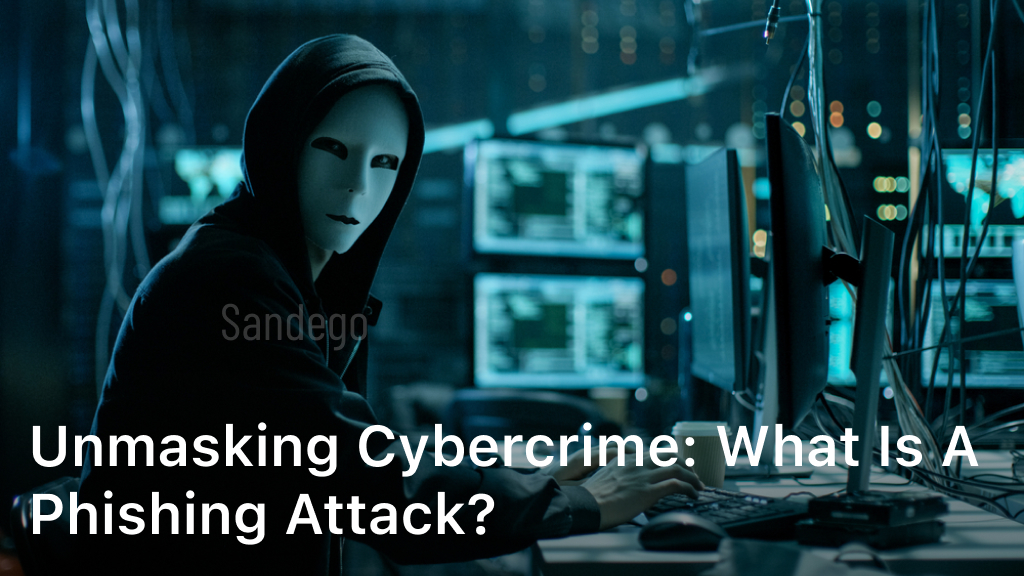What is a Phishing Attack?
In today’s digital age, cybercrime has become an ever-growing concern. One of the most common forms of cybercrime is the phishing attack.
So, what is a phishing attack? Simply put, it’s a fraudulent attempt by cybercriminals to obtain sensitive information from unsuspecting victims.
This can include passwords, credit card numbers, and other personal data. In this section, we’ll explore the ins and outs of phishing attacks and provide tips on how to protect yourself from falling victim to cybercrime.
As technology evolves, the methods used by cybercriminals become more sophisticated and difficult to detect. That’s why it’s essential to know the warning signs and be aware of the various types of phishing attacks out there. By staying informed and taking proactive steps to secure your information, you can stay one step ahead of these malicious actors. So, let’s dive in and explore the world of phishing attacks together.
Stay tuned for our comprehensive explanation of phishing attacks and how to protect yourself. By the end of this guide, you’ll be equipped with the knowledge and tools necessary to stay safe online.
Keywords: phishing attack, cybercrime, stay safe online
Understanding Phishing Attacks
Phishing attacks are a type of cybercrime that can affect anyone who uses the internet. They are designed to trick you into sharing sensitive information, such as your login credentials, credit card details, or social security number. Understanding how they work is the first step in protecting yourself from falling victim to them.
The Tactics of Phishing Attacks
Phishing attacks can take many different forms, but they typically involve the use of social engineering tactics to gain your trust. This may involve posing as a trustworthy source, such as a reputable company, government agency, or colleague, in order to convince you to disclose your personal information.
The Goals of Phishing Attacks
Phishing attacks are usually motivated by financial gain, identity theft, or corporate espionage. Cybercriminals may use the information they obtain to steal money from your bank account, open new credit cards in your name, or sell your personal data on the black market.
The Methods of Phishing Attacks
Phishing attacks can be carried out through various means, including email, social media, text messages, phone calls, and fake websites. They may also use malware, such as keyloggers or ransomware, to gain access to your computer or mobile device.
Now that we have a basic understanding of what phishing attacks are and how they operate, let’s take a closer look at the different types of phishing attacks.
Common Types of Phishing Attacks

Phishing attacks come in various shapes and sizes, and it’s important to be aware of the most common types that cybercriminals use to target unsuspecting victims. Here are some of the most prevalent forms of phishing attacks:
Email Phishing
This is the most common form of phishing attack, and it involves sending fraudulent emails that appear to be from a legitimate source, such as a bank, social media platform, or e-commerce website. These emails often contain a link that takes the victim to a fake website designed to steal their personal information.
Spear Phishing
This type of phishing attack is more targeted and personalized, as cybercriminals research their victims and use their personal information to craft convincing messages. Spear-phishing attacks commonly target employees of a specific organization, as well as high-profile individuals, such as CEOs and government officials.
Smishing
Smishing is a form of phishing attack that uses SMS messages to lure victims into clicking on fraudulent links or downloading malicious attachments. These messages often appear to be from a trusted source, such as a bank or delivery company.
Vishing
Vishing, or voice phishing, is a tactic that involves cybercriminals calling their victims and pretending to be someone they’re not, such as a bank representative or IT support technician. The goal is to trick the victim into revealing their personal information or passwords over the phone.
Pharming
Pharming is a more sophisticated type of phishing attack that involves redirecting a victim’s web traffic to a fake website, even if they enter the correct URL into their browser. Cybercriminals do this by installing malware or manipulating the victim’s DNS settings.
By familiarizing yourself with these common types of phishing attacks, you’ll be better equipped to spot suspicious messages and avoid falling victim to cybercrime.
Warning Signs of a Phishing Attack
Phishing attacks can be sophisticated, but there are some red flags that can help you spot them. By knowing what to look for, you can protect yourself from becoming a victim of cybercrime. Here are some warning signs:
Urgent or Threatening Language
Phishing emails often use urgent or threatening language to pressure you into taking immediate action. For example, they may claim that your account has been compromised or that you owe money and must pay immediately. Don’t fall for these scare tactics.
Suspicious URLs
Phishing emails often contain links to website that look legitimate but are actually fake. Check the URL carefully before clicking on any links. If it looks suspicious or has typos, don’t click on it.
Grammatical Errors
Phishing emails often contain grammatical or spelling mistakes. Legitimate companies usually proofread their emails before sending them out, so any errors could be a sign that the email is fake.
Requests for Personal Information
Phishing emails may ask you to provide personal information, such as your social security number, credit card details, or login credentials. Legitimate companies would never ask for this information via email. If you receive such a request, do not respond.
Unknown Sender
If you don’t recognize the sender of an email, be wary. Phishing emails often come from unfamiliar email addresses or impersonate someone you know, such as a coworker or friend. Check the email address carefully before responding.
By keeping an eye out for these warning signs, you can protect yourself from falling victim to a phishing attack. Don’t take any chances with your online security – stay vigilant and stay safe.
Protecting Yourself Against Phishing Attacks
Phishing attacks can be very dangerous, but there are simple steps you can take to protect yourself. Here are some tips:
Create Strong Passwords
Using a strong, unique password for each of your accounts is crucial. Avoid using common words or phrases. Include a mix of uppercase and lowercase letters, numbers, and symbols. You can also use a password manager to generate and store strong passwords for you.
Enable Two-Factor Authentication
Two-factor authentication adds an extra layer of security to your online accounts. It requires you to enter a code or use a biometric factor, such as a fingerprint, in addition to your password. Make sure to enable this feature on any account that offers it.
Stay Vigilant
Always be cautious when opening emails or messages from unknown senders. Check the sender’s email address and look out for any suspicious URLs or attachments. If something seems off, don’t click on it. It’s better to err on the side of caution.
Update Your Software
Make sure to keep your operating system and software up to date. This helps ensure that any vulnerabilities that could be exploited by cybercriminals are patched and fixed.
Use Anti-virus Software
Installing anti-virus software can help protect your computer from malware and other cyber threats. Make sure to keep it updated and run regular scans.
Be Wary of Public Wi-Fi
When using public Wi-Fi, be cautious of the websites you visit and the information you enter. Avoid accessing sensitive information, such as online banking or personal email, when using public Wi-Fi.
By using these tips, you can stay safe online and protect yourself against phishing attacks.
Reporting Phishing Attacks
If you’ve fallen victim to a phishing attack or suspect that you’ve encountered one, it’s essential to report it as soon as possible. Not only does reporting these incidents help prevent further harm, but it also helps authorities track down and prosecute cybercriminals.
Step 1: Don’t Respond
The first and most crucial step in reporting a phishing attack is to refrain from responding to any suspicious emails or messages. This includes clicking on any links or downloading any attachments included in the message. Responding to phishing attempts can put your personal information and devices at risk.
Step 2: Report the Incident
Once you’ve identified a phishing attack, report it to the appropriate parties immediately. This includes your financial institution or credit card company, as well as the Federal Trade Commission (FTC). You can also report phishing attempts to the Anti-Phishing Working Group (APWG) or the Internet Crime Complaint Center (IC3), which both work to combat cybercrime.
Step 3: Protect Yourself
After reporting the phishing attempt, take steps to protect yourself from further attacks. This includes changing your passwords, monitoring your credit reports, and updating your anti-virus software. Be sure to stay vigilant and watch out for any suspicious activity in the future.
By reporting phishing attacks, we can help to combat cybercrime and protect ourselves and others from falling victim to these scams. Remember, staying informed and alert is the key to staying safe online.
Conclusion
In conclusion, cybercrime is a grave threat that cannot be ignored. Phishing attacks, in particular, are becoming increasingly sophisticated and prevalent, targeting individuals and organizations worldwide. It’s essential to understand what phishing attacks are, how they work, and what you can do to protect yourself.
By staying informed and vigilant, using robust security measures, and reporting any suspicious activity promptly, you can minimize the risk of falling victim to a phishing attack. Remember, prevention is crucial, and being proactive is the best defense against cybercrime.
Thank you for joining us on this journey to unmask cybercrime and stay safe online. We hope the information we’ve provided has been helpful and informative. Stay safe out there!
FAQ
1. What is a phishing attack?
Answer : A phishing attack is a fraudulent activity in which cybercriminals impersonate reputable organizations or individuals to deceive victims into providing sensitive information, such as usernames, passwords, or credit card details. These attacks typically occur through email, text messages, or fake websites.
2. How can I protect myself from phishing attacks?
Answer : To protect yourself from phishing attacks, it is important to be cautious and vigilant. Avoid clicking on suspicious links or opening attachments from unknown sources. Verify the authenticity of emails and websites by checking for signs of phishing, such as misspellings, grammatical errors, or mismatched URLs. Additionally, enable two-factor authentication, keep your software up to date, and regularly review your financial transactions for any unauthorized activity.





